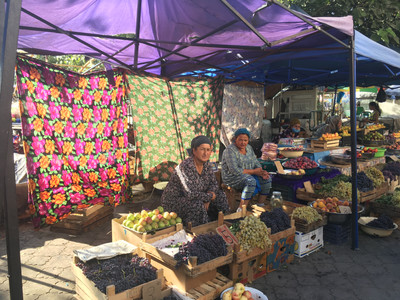Tajikistan - Khujand
- Polina Rendak
- Jan 26, 2020
- 2 min read
Updated: Mar 30, 2021

Founded in c. 7th century B.C., once an important part of the Silk Road, at some point called Leninabad, Khujand has plenty to offer: if you appreciate beautiful nature and enjoy simple but delicious local cuisine, this is the place to visit.
Just look at these sunsets over the Syr Darya river...
Panchanbe Market, the largest market in Khujand, is in the very center of the city, opposite the square from the Mausoleum of Sheik Muslihiddin pictured above. The main pavillion of the bazaar was built in 1960s and illustrates a mixture of the Sovet and the Eastern decorative and architectural styles. Quite a colorful mix!

"Panchanbe" means "Thursday", while "Dushanbe", which happens to be the name of Tajikistan's capital city, means "Monday". The names come from a fact that historically, in Khujand, trading at the market happened on Thursdays, and in Dushanbe - on Mondays.
You can find quite exotic items at the market - from pryaniki so close to my post-Soviet Russian heart to bits of chalk (a must-buy for all pregnant women, as it was marketed by a trader at the stall) and kurt balls (drained yogurt or sour milk shaped as balls and let dry; a great unsweet healthy snack, although somewhat high in calories).
If you are a fan of quality textiles, definitely head to one of local textiles shops and you will find all sorts of colors and prints there. Some traditional "blurry" prints of colorful shapes can make a great souvenir for someone who likes sewing. Quality textiles here are much cheaper than in Europe and the US, from my experience... Just be careful not to support child or forced labour through you purchases - best to enquire before buying about the way the textiles are produced.
For those vying to learn some bits and pieces about the history of the 2,500-year-old city, the Historical Museum of the Sughd Region is a must-visit. For a modest fee you can take advantage of a private tour available in Tajik, Russian and English (although some prior arrangement might be helpful, particularly with the English option, as the guides may not be readily available).
The building of the Historical Museum incorporates the remnants of what once was the Khujand fortress destroyed by Genghis Khan in the 13th century after a long and fierce siege that was part of the Mongol invasions across the region. The fortress's defence was led by Temur Malik, considered these days a national hero in Tajikistan.




Once you are done with the Museum and the nearby municipal park, you can take a funicular to the other bank of the Syr Darya river and enjoy the stunning sunset over the city during your ride.

If you travel to your next destination by plane you are guaranteed some stunning views of the city and the surrounding mountains, fields and the river. To get to London, I took a direct flight from Khujand to Moscow, which let me take in the gorgeous views of Tajik mountains, Uzbek cotton fields, Kazakh steppes, the Aral sea-lake and other things out there. From Moscow (Domodedovo Airport), I continued to London.





























Comments